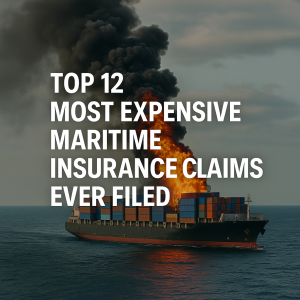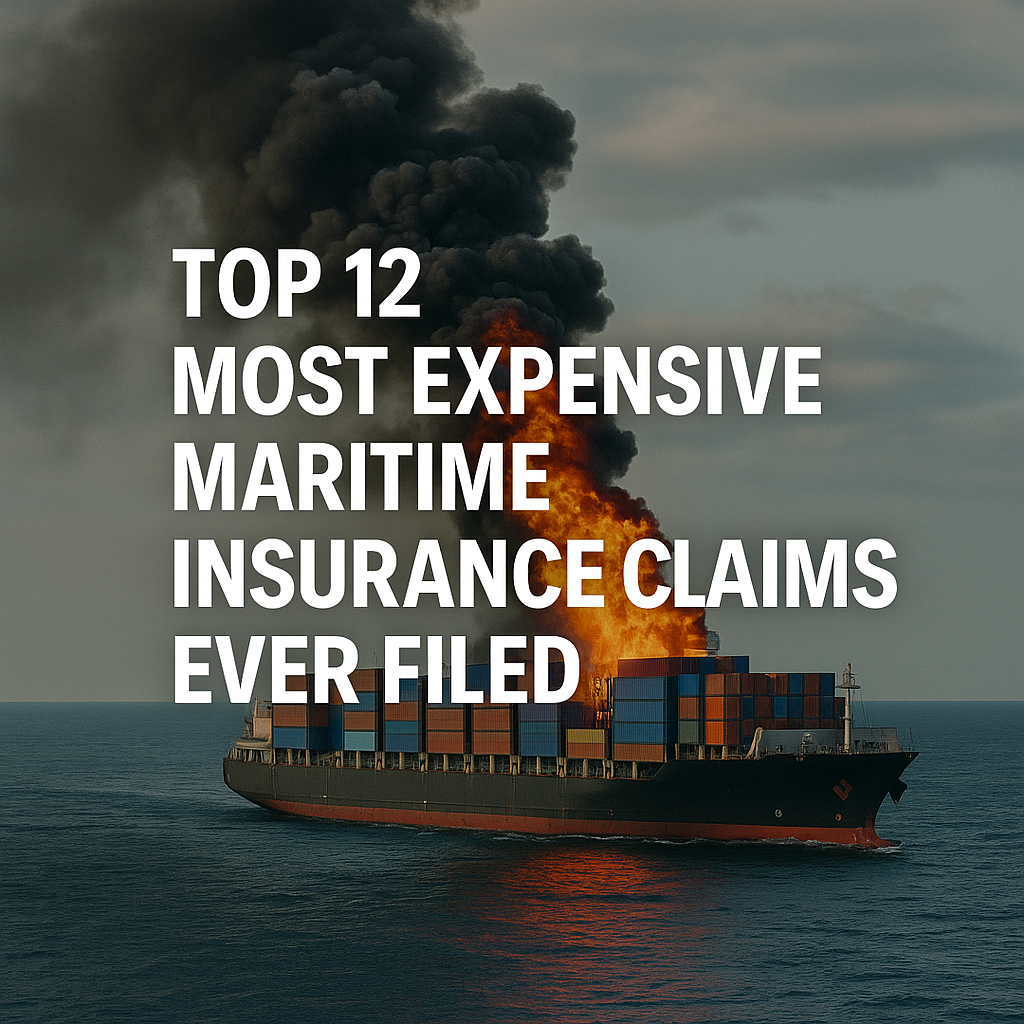 Discover the largest maritime insurance claims ever filed — from the Costa Concordia to the Baltimore Bridge Strike. Learn how these billion-dollar disasters reshaped marine risk, P&I clubs, and global shipping.
Discover the largest maritime insurance claims ever filed — from the Costa Concordia to the Baltimore Bridge Strike. Learn how these billion-dollar disasters reshaped marine risk, P&I clubs, and global shipping.
The world of marine insurance may seem remote to most people — until disaster strikes. When ships collide, capsize, or spill oil into the sea, the consequences can run into billions. From tragic loss of life to environmental destruction and massive legal liabilities, these events test the very foundations of global maritime insurance.
Why These Mega-Claims Matter
Huge maritime insurance claims are more than sensational headlines — they are turning points that reshape how ships are built, managed, and insured. Their ripple effects reach far beyond the ocean, influencing:
- Insurance markets: major losses push up premiums, stress reinsurers, and change underwriting models.
- Regulation: accidents inspire new conventions and stricter compliance regimes.
- Technology and safety: better navigation, sensors, and crew training arise from the lessons learned.
- Global trade: a single incident can paralyze ports and supply chains worldwide.
Understanding these claims helps maritime stakeholders strengthen resilience and reduce future risks.
–
How the Ranking Was Built
This list considers marine insurance and maritime-related liability claims, focusing on verified or widely reported losses involving ships, ports, offshore assets, or maritime infrastructure.
Amounts are presented in approximate U.S. dollar values and reflect total insured losses, including hull & machinery, cargo, P&I, wreck removal, environmental cleanup, and third-party damages.
1. Baltimore Bridge Strike – MV Dali (2024)
On 26 March 2024, the container ship Dali lost power while departing the Port of Baltimore and struck a support column of the Francis Scott Key Bridge. The bridge collapsed within seconds, cutting a vital transport artery and killing six workers.
The estimated insured losses range from USD 2 to 4 billion, potentially making this the largest maritime insurance claim in history. Liabilities include bridge reconstruction, port closure, salvage, and third-party lawsuits.
The case has reignited debate over liability limitation under U.S. maritime law and may redefine future P&I and reinsurance structures.
2. Costa Concordia Disaster (2012)
On 13 January 2012, the Italian cruise ship Costa Concordia struck submerged rocks near Isola del Giglio and capsized. Thirty-two people died, and the complex salvage operation lasted over two years.
Total insured losses reached around USD 1.5–2 billion, covering hull damage, wreck removal, passenger compensation, and pollution cleanup. The event remains one of the most expensive cruise-ship losses ever, transforming safety culture across the passenger-shipping industry.
3. Deepwater Horizon / Macondo Blowout (2010)
An explosion aboard the offshore drilling rig Deepwater Horizon in the Gulf of Mexico killed 11 workers and caused the largest marine oil spill in U.S. history.
Although overall corporate liabilities exceeded USD 60 billion, insured losses related to marine and offshore risk alone were estimated at around USD 1.4 billion. The disaster blurred the line between offshore energy and marine insurance, spurring reforms in safety and environmental oversight.
4. Tianjin Port Explosion (2015)
In August 2015, a massive series of chemical explosions rocked Tianjin Port, China’s busiest northern gateway. Thousands of containers, vehicles, and warehouses were destroyed.
Insurers faced USD 5–6 billion in combined claims, much of it under marine cargo and port liability policies. The catastrophe became a reference case for port-area risk assessment and cargo-storage safety worldwide.
5. Ever Given and the Suez Canal Blockage (2021)
When the 400-metre container ship Ever Given ran aground in the Suez Canal, global trade literally stopped. For six days, over 400 ships were delayed, costing billions in lost revenue and freight penalties.
Although physical damage to the ship was limited, indirect liabilities — including compensation to the Suez Canal Authority, cargo delays, and supply-chain disruption — pushed potential insured exposure to around USD 3 billion.
The incident highlighted how a single navigational error can trigger global economic shockwaves.
6. Salem (Supertanker) Fraud Case (1980)
The supertanker Salem, later renamed Sea Sovereign, disappeared under mysterious circumstances after allegedly offloading oil secretly and being scuttled to claim insurance.
Insurers received a USD 56 million claim for the lost cargo — an enormous sum at the time. Investigations later uncovered fraud, leading to criminal prosecutions.
This case remains one of the most notorious examples of marine-insurance deception, emphasizing the need for tight verification and anti-fraud controls.
7. Torrey Canyon Oil Spill (1967)
The Liberian-registered supertanker Torrey Canyon ran aground off Cornwall, spilling nearly 120 million litres of crude oil. The disaster devastated coastlines in the UK and France and forced governments to pioneer new cleanup methods.
Although total costs were modest by today’s standards, the legal aftermath created the 1969 Civil Liability Convention and 1971 Fund Convention, establishing modern rules for ship-source pollution liability. Adjusted for inflation, this remains one of the most consequential — and expensive — environmental claims in maritime history.
8. Exxon Valdez Oil Spill (1989)
The grounding of the Exxon Valdez in Prince William Sound, Alaska, spilled about 37,000 tons of crude oil.
Cleanup, settlements, and fines reached around USD 3.8 billion, while subsequent legal appeals pushed punitive damages even higher. Marine insurers faced immense exposure under pollution and liability policies.
The event triggered stricter tanker-design standards and the U.S. Oil Pollution Act of 1990.
9. Prestige Tanker Sinking (2002)
In November 2002, the Prestige, carrying 77,000 tons of heavy fuel oil, broke apart off Spain’s coast, spilling thousands of tons into the Atlantic.
Cleanup and compensation claims exceeded USD 1 billion, with protracted international litigation lasting over 15 years. The case reshaped Europe’s maritime-liability framework and accelerated the phase-out of single-hull tankers.
10. Amoco Cadiz Oil Spill (1978)
Another defining pollution case: the supertanker Amoco Cadiz ran aground off Brittany, France, releasing 220,000 tons of oil.
More than 300 kilometres of coastline were polluted. The French government and thousands of claimants sued the vessel’s owner, eventually receiving a settlement of around USD 250 million (over USD 1 billion today).
The case established precedent for corporate liability in foreign maritime courts.
11. Estonia Passenger Ferry Sinking (1994)
The sinking of the MS Estonia in the Baltic Sea killed 852 people, making it one of Europe’s deadliest peacetime maritime disasters.
Insurance payouts covered the vessel, passenger claims, and state compensation, totaling approximately USD 500 million. Beyond cost, the tragedy led to significant reforms in ro-ro ferry safety and evacuation procedures.
12. Herald of Free Enterprise Capsizing (1987)
The roll-on/roll-off ferry Herald of Free Enterprise capsized minutes after leaving Zeebrugge, Belgium, killing 193 people.
The total insured loss was about USD 150 million. Yet its greater legacy lay in the industry-wide focus on safety culture, leading to the ISM Code (International Safety Management) that governs today’s ship operations.
The Anatomy of a Billion-Dollar Maritime Claim
What turns a routine accident into a record-breaking loss?
Multiple Insurance Layers
Maritime losses often combine:
-
Hull & Machinery – vessel damage
-
Protection & Indemnity (P&I) – third-party liabilities
-
Cargo Insurance – owners’ goods
-
Port & Terminal Policies – infrastructure damage
-
Business Interruption – supply-chain disruption
Each adds another layer to the financial total.
Legal and Regulatory Complexity
International conventions and domestic laws define who pays what. Limitation regimes, jurisdiction disputes, and liability caps can take years to resolve.
Environmental and Long-Tail Impacts
Oil spills, toxic discharges, and wreck removals generate costs for decades. Cleanup and restoration often exceed the initial damage claim.
Salvage and Wreck Removal
Modern wreck-removal operations are engineering marvels — and enormously costly. The Costa Concordia salvage alone exceeded USD 1 billion.
Supply-Chain Shockwaves
When canals close or ports are blocked, costs ripple across continents. Business-interruption coverage becomes crucial for both shipowners and cargo interests.
Emerging Trends in Maritime Insurance Risk
1. Supply-Chain Exposure
Globalized logistics mean one blocked waterway can cost billions. Insurers now model cascading disruptions rather than isolated ship losses.
2. Climate and Extreme Weather
Stronger storms, shifting currents, and rising seas increase grounding and collision risk. Advanced satellite forecasting and vessel monitoring help mitigate exposure.
3. Automation and Cybersecurity
Digital navigation systems improve safety but introduce cyber vulnerabilities. A hacked ECDIS or AIS network could cause collisions — a new frontier for marine underwriters.
4. Environmental Accountability
Governments and societies expect polluters to pay. Stricter liability conventions and carbon-emission rules are expanding insurers’ responsibilities.
5. Reinsurance Pressure
After recent mega-losses, reinsurance costs have surged. P&I clubs rely heavily on global pooling to stay solvent.
6. Data-Driven Underwriting
Insurers now use big data, predictive analytics, and real-time vessel monitoring to refine premiums and detect anomalies before they lead to loss.
Case Comparisons and Lessons Learned
Costa Concordia vs Baltimore Bridge Strike
Both involved human error, but their financial structures differ: one centered on a cruise ship and passenger liability, the other on infrastructure destruction and port shutdowns. The latter could redefine the limits of marine insurance coverage.
Ever Given vs Deepwater Horizon
The Suez Canal blockage demonstrated systemic vulnerability; Deepwater Horizon showed technological and environmental risk. Together, they reveal that marine insurers must account for both human navigation and industrial complexity.
Torrey Canyon vs Exxon Valdez*
These oil-spill cases decades apart show the evolution of international law — from fragmented national claims to harmonized global conventions enforcing strict liability and compulsory insurance.
Frequently Asked Questions (FAQ)
What’s the difference between Hull & Machinery and P&I insurance?
H&M covers the vessel itself; P&I covers liabilities to others such as pollution, collision damage, or injury.
Can shipowners limit their liability after a disaster?
Yes. Many jurisdictions allow limitation to the vessel’s post-casualty value plus freight, though courts may deny it in cases of gross negligence.
Why do business-interruption costs often exceed repair bills?
Because the economic value of trade and port activity halted by an accident can surpass the ship’s own worth.
Who pays for oil-spill cleanup?
Usually the shipowner and its P&I club under international conventions, backed by national funds such as the IOPC Fund.
How long do large maritime claims take to settle?
Anywhere from a few years to decades, depending on litigation, environmental restoration, and international arbitration.
Conclusion
From the capsized Costa Concordia to the shattered Baltimore Bridge, maritime insurance history is filled with staggering figures — and sobering lessons. These billion-dollar claims highlight how interconnected modern shipping has become and how fragile global supply chains truly are.
They also show the resilience of maritime law and insurance institutions, which continue to evolve with technology, environmental awareness, and global trade.
For seafarers, insurers, and policymakers, each loss is both a tragedy and a teacher — reminding the world that safety, vigilance, and innovation at sea are worth every investment.
References
-
The Maritime Executive. Baltimore Bridge Strike Could Be the Most Expensive Marine Casualty Ever.
-
Lockton Global. The Baltimore Bridge Collapse: A $4 Billion Question.
-
Marine Insight. Largest Maritime Insurance Payouts.
-
Insurance Business Mag. Wrecked Container Ship Sparks $1.1 Billion Insurance and Liability Crisis.
-
Wikipedia. Francis Scott Key Bridge Collapse; Ever Given; Costa Concordia; Deepwater Horizon; Torrey Canyon; Salem (Supertanker); Exxon Valdez; Amoco Cadiz; Prestige; MS Estonia; Herald of Free Enterprise.
-
Scarbrough Global Logistics. Tianjin Port Explosion May Rank as Worst Marine Insurance Disaster.
-
Wall Street Journal. Suez Canal Insurance Claims Loom as Ever Given Blocks Shipping.
-
Journal of Maritime Law & Commerce. Pollution Liability Conventions and Insurance Frameworks in Modern Shipping.
-
International Group of P&I Clubs. Annual Reports on Major Claims and Pooling Arrangements.


This is exactly the kind of content I’ve been searching for.
You have a real gift for explaining things.
I enjoyed your perspective on this topic. Looking forward to more content.
Thanks for making this easy to understand even without a background in it.
Thank you for being so generous with your knowledge.
Your thoughts are always so well-organized and presented.